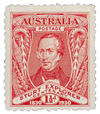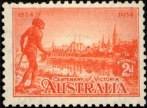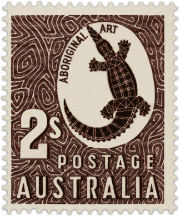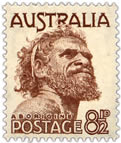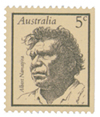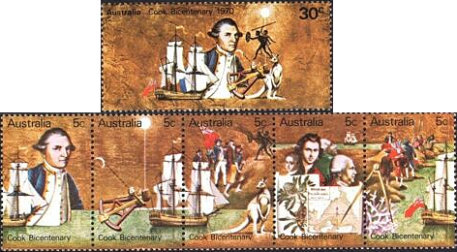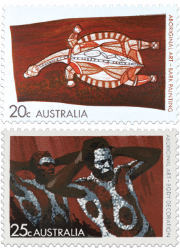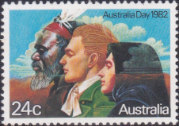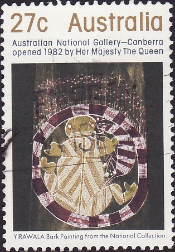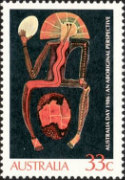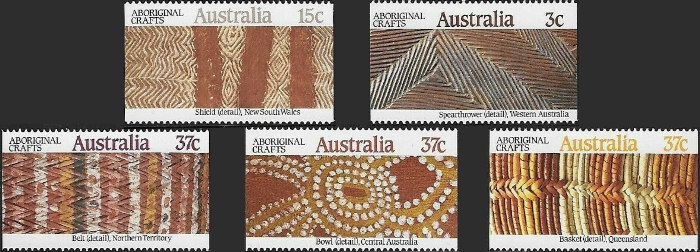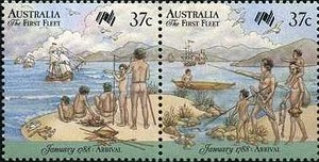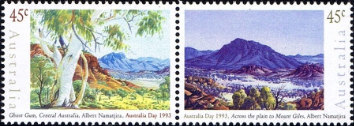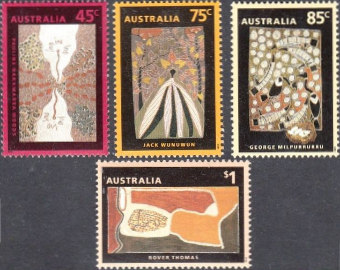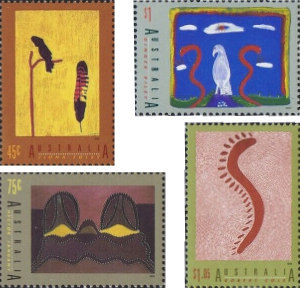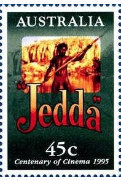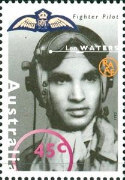Aboriginal timeline: Stamps
Found 52 results for your search. Showing page 1 of 3.
1930
-

1930: Can you find all elements in the stamp? The first stamp of Australia showing a reference to Aboriginal culture celebrates the centenary of Exploration of Murray River (1½d red and 3d blue). It shows a boomerang, a coolamon, two spear heads and Lyre bird tail feathers.
1934
-

One of the earliest Australian stamps with a reference to Aboriginal culture. The 1934 stamp issue shows an Aboriginal man with spears walking towards a river that separates him from the town beyond, almost as if to show the contrast between pre and post invasion conditions. There were three denominations to the set.
1948
-

Designed by a non-Aboriginal artist, this 2-shilling stamp is the first to show an Aboriginal art theme. Australia Post releases the first Australian stamp that features an Aboriginal art theme. The 2 shilling stamp represents a crocodile in the style of a rock painting and is part of the Australian Animals definitive stamp issue of that year. But the artist, Gert Sellheim, is not Aboriginal.
1950
-

Gwoya Jungarai The portrait of Gwoya Jungarai (c.1895-1965, also spelled Tjungurrayi or Djungarai) of the Warlpiri people, Central Australia, appears on the 8 1/2 pence (8 1/2d) and two shillings and sixpence (2s.6d, issued 1952) definitive stamps. It is the first time a living Australian — settler or Aboriginal — is featured on a stamp.
The stamps become widely known as “One Pound Jimmy” because when asked the price of his artefacts for sale Gwoya always replied “One Pound”. Tjungurrayi was a stockman, traditional lawman, and survivor of the brutal 1928 Coniston massacre. His portrait is later engraved on the two dollar coin.
1968
-

Stamp celebrating Aboriginal artist Albert Namatjira. First named Aboriginal person honoured on an Australian stamp. Artist Albert Namatjira appears on the Famous Australians issue. He was also the first Aboriginal person to be accepted as a citizen of the Commonwealth in 1957.
1970
-
A stamp issue for Australia's 200th anniversary of "first European contact" at the east coast centres around Captain Cook. A mini sheet issued by Australia Post annotates the third stamp of the series (which shows Aboriginal people in the top right corner) with "where he finds new people and strange animals", conveniently omitting conflict.

The Bicentenary issue put Aboriginal people into the far background. Can you spot them?
1971
-

The first issue showing Aboriginal art did not mention the artist but avoided culturally sensitive material. Australia Post releases the first stamp issue to focus on traditional, authentic Aboriginal art forms, titled "Aboriginal Art". While focusing on traditional arts forms, the stamps does not yet name the artist (which started with the 1988 issue).
The 20c design is based on a bark painting of a long necked tortoise from Western Arnhem Land; the 25c, was based on a photograph by Australian anthropologist, Sir Baldwin Spencer (see below); the 30c shows rock paintings of a cave in the Oenpelli area of Western Arnhem Land; the 35c depicts grave posts used in mourning ceremonies on Bathurst & Melville Islands.
The 25 cent stamp shows body decoration used in the final mourning ceremony by the Warramunga people, from the Tennant Creek area in the Northern Territory. The image shows two men in the act of painting each other, which the Warramunga people considered a sacred ceremony to be only witnessed by men. The artist changed the final design so women can also view it. [1]
1982
-

The Australia Day 1982 stamp tried to convey a sense of unity of diverse Australians. A stamp for Australia Day shows the head of an Aboriginal man, along with that of a European colonist and an immigrant. The stamp's design symbolises the three waves of migration to Australia: Aboriginal people from south-east Asia, the British and European post-war immigrants.
-

The stamp shows Gurgurr the Moon man, and his dog Mulutji. Australia Post issues a stamp commemorating the opening of the National Gallery, Canberra. The design shows an Aboriginal bark painting of Gurgurr the Moon man, and his dog Mulutji as they appear on the moon. The artist is not mentioned.
-
Australia Post issues a set of four stamps themed Aboriginal Culture in Music and Dance. It is the first time actual Aboriginal work appears on Australian stamps. All designs show bark paintings of Mimi spirits dancing. The artists are David Milaybuma (27c), Lofty Nabardayal (40c), Jimmy Galareya (65c) and Dick Nguleingulei-Murrumurru (75c).

Mimis are fairy-like beings of Arnhem Land (NT) and have extremely thin and elongated bodies. They live in rock crevices and sometimes taunt people.
1984
-
The first stamp issue for the Australian Bicentennial shows Aboriginal rock art. It is interesting to note that the series is titled "First Australians" which only much later was agreed to be one of the appropriate terms for Aboriginal people. The first stamp introduces the bicentennial symbol. Australia Post also published a booklet with detailed explanations of the stamps called The First Australians: Our Heritage in Stamps (Australian Bicentennial Collection).
The designs show stick figures (Cobar Region, NSW), Bunjil's Cave (Grampians, WA), Quirkan Gallery (Cape York, QLD), a Wandjina spirit with snake babies (Gibb River, Kimberley, WA), a rock python (Gibb River), a silver barramundi (Kakadu National Park, Alligator Rivers Area, NT) and a rock possum (Kakadu National Park).


Although the captions use "First Australians" they fail to explain the locations of the rock art, a lost opportunity to raise awareness of this rich cultural heritage.
1986
-

A Wandjina spirit protects the land. This stamp issue shows the continent of Australia cradled and protected by a Wandjina spirit. He holds a second egg in his hand, a symbol of perfection and rebirth. It also refers to the unbroken (and still misunderstood) Aboriginal spirit and how the land owns its people.
1987
-
Australia Post issues a set of 5 stamps with details of Aboriginal crafts. The stamps show patterns on a basket (from Arukun, QLD; 37c), a spear thrower (Warburton River, WA; 3c), a bowl (Pintubi people of Central Australia; 37c); a belt (Arnhem Land, NT; 37c) and a shield (New South Wales; 15c).

Aboriginal people used ochres and grasses of different colours to create the patters seen in their craft.
1988
-

Aboriginal people's reception of the First Fleet was not as passive and peaceful as shown here. Two stamps of the Australia Day issue show an Aboriginal family watching the arrival of the First Fleet. They are relaxed and just looking on, a misrepresentation of the resistance Aboriginal people showed when they first encountered the British.
-
Australia Post issues four stamps celebrating the Art of the Desert. All paintings selected for this issue depict an event in the Dreaming: Bush Potato Country (Turkey Tolsen Tjupurrula & David Corby Tjapaltjarri, 37c), Courtship Rejected (Limpi Puntungka Tjapangati, 55c), Medicine Story (unknown artist, 90c) and Ancestor Dreaming (Tim Leura Tjapaltjarri, $1).

The issue features four stamps from the Flinders University Art Museum that depict an event in the Dreaming.
1993
-
To celebrate the International Year of Indigenous People, Australia Post issues two stamps for Australia Day that celebrate Aboriginal painter Albert Namatjira and his watercolour style. The stamps show a ghost gum and Mount Giles.

Albert Namatjira was famous for his use of water colours. -

The common theme of these paintings is 'Dreaming'. Australia Post issues a set of four stamps to celebrate the International Year of Indigenous People showing paintings by Aboriginal artists. They are: Wild Onion Dreaming by Pauline Nakamarra Woods (45c), Yam Plants by Jack Wunuwun (75c), Goose Egg Hunt by George Milpurrurru (85c) and Kalumpiwarra-Ngulalintji by Rover Thomas ($1).
-

This set showcases the work of four different Aboriginal artists. A second set of stamps celebrates the International Year of Indigenous People with the designs for this issue based on four Aboriginal artists' work: Black Cockatoo Feather by Fiona Foley (45c), Ngarrgooroon Country by Hector Jandany (75c), Ngak Ngak by Ginger Riley Munduwalawala ($1) and Untiled by Robert Cole ($1.05).
1995
-

Jedda was the first Australian feature to employ Aboriginal lead actors. One stamp in the Centenary of Cinema issue features Jedda – the first Australian feature film to use Aboriginal actors in the lead roles and the first to be filmed in colour.
-

Len Waters was a fighter pilot for the RAAF. Streets in ACT and Sydney bear his name. In its second Australia Remembers issue, Australia Post features Len Waters who became the first Aboriginal military pilot accepted into the Royal Australian Air Force and the only Aboriginal fighter pilot to serve during World War II.
References
View article sources (1)
[1]
'Aboriginal artwork represented on stamps', Australia Post 26/10/2017
